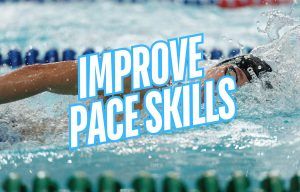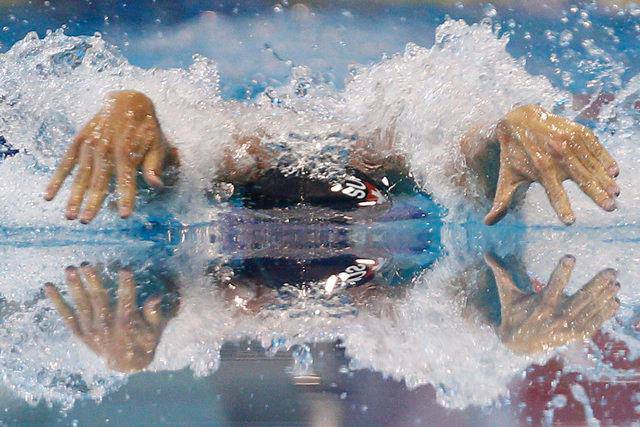
How to Improve Your Pacing Skills
Looking to up your pacing skills in the pool? Here are some actionable pacing tips and tools to help you master pace and your performance on race day.

The best swimmers in the world use a swimming log to monitor their performances. You know these people, they are the ones scribbling in a notebook after workout, or the first to check out their splits after a race.
These high-performing athletes know something the rest don’t– that there is a tremendous amount of valuable information that can be extracted by taking a bird’s eye view of their performances. Having a swimming log provides this objective overview.
SEE MORE: YourSwimLog — the Ultimate Swim Log
Just imagine the incomparable advantage you would have over your fellow swimmers when you get your hands on a tool that gives you the exact reasons why you swam awesome one day and horrible the next.
Your swimmers log can be as basic in its detail or as comprehensive as you like. This is the magic of your swimming log– it is totally yours.
It goes without saying that when you make simple entries in your swimming log you are going to limit yourself in the amount of feedback you can pull from it. Conversely, when you carefully scribe all the variables of your workout (diet, sleep, stress levels, etc) you can mine a huge amount of information that will explain your performances.
SEE ALSO: 8 Reasons to Keep a Swim Log
Here are three quick factors to keep in mind when using your swimming log:
My favorite part of using a swimming log is that you can assign daily and weekly goals to your practices and/or competitions. This is a fantastic way to stay focused and to improve the little things in your swimming.
Goals for an Individual Workout: No breathing in and out of the walls for the main set. Stretch for 15 minutes after practice. Drink protein shake immediately after to enhance recovery.
Goals that Stretch Over the Course of a Week or Longer: Make it to every single practice. Do 300 abs before every workout. Do an extra 300 meter warm-down.
Season Long Goals: Qualify for the traveling team. Break:55 seconds for 100 yard breaststroke.
What this means is, is that it isn’t enough to simply write out what you did for your workout that day in your swimming log. If you simply want to track mileage over a course of time this works just fine, but it you want to find trends and reasons behind your practices you will want to also note:
* The results. Make note of some of the times you put down on the main sets. If you can remember them note your stroke counts, and heart rate as well.
* How you were feeling in the water that day. Were you gliding along, or were you really struggling to get a hold of your stroke?
* The effort that you gave during the main set(s). Did you give it your all, or did you leave some in the tank?
* Your level of focus. Were you “in the zone” or was your mind bouncing with thoughts of outside matters such as school or relationships?
* Your levels of stress. Were you feeling overly stressed that day? Or not at all?
* Your diet for the day. Did you fall prey to convenience food or did you stick to your diet plan?
* Your recent sleeping habits. Have you been getting a solid 8 hours, or have you been having poor sleeps?
* Any other factors that may have any effect on the performance you give.
You should make notes about your workout when they are the most fresh in your mind. Sometimes waiting to get home can skew the memories of exactly what happened. Have your swimming log in your swim bag and you will have instant and ready access to it.
Using a swimming log is a proven and time-tested method to improve performance. The best part is that it is you can start doing it immediately, and it’s not something that requires learning some new swimming technique or taking some miracle supplement.

Olivier Poirier-Leroy Olivier Poirier-Leroy is the founder of YourSwimLog.com. He is an author, former national level swimmer, two-time Olympic Trials qualifier, and swim coach.
✅ Free shipping on Orders over $49
✅ Price Match Guarantee
✅ Best selection of gear for training and competition
✅ Fast and Easy Returns

“This is the best book I have ever seen concerning mental training.” — Ray Benecki, Head Coach, The FISH Swim Team


Looking to up your pacing skills in the pool? Here are some actionable pacing tips and tools to help you master pace and your performance on race day.

Looking for tips on how to use a drag chute for improved swim performances? Read on for some proven tips, sets, and pointers for training with a chute.

Ready to take your swimming to the next level? Here are seven ways that a drag chute can help you become a better and faster swimmer.

Wondering if a swim bench can help improve your swimming? Here are six benefits of swim benches for better technique, more power, and faster swimming.

Not breathing into the walls is one of the fundamental skills developing swimmers are taught. Here is how powerful a no-breath approach is for turn and swim speed. Strong training habits are something swimmers hear a lot about from their earliest days of their competitive swimming careers. The greatest hits

Drills with a swim snorkel are one of the best ways to maximize engagement and skill development. Here are five swim snorkel drills to try for faster swimming.
SITE
SHOP
GUIDES

LANE 6 PUBLISHING LLC © 2012-2025
Join 33,000+ swimmers and swim coaches learning what it takes to swim faster.
Technique tips, training research, mental training skills, and lessons and advice from the best swimmers and coaches on the planet.
No Spam, Ever. Unsubscribe anytime.
